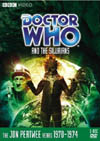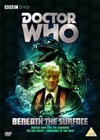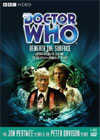DVD Extras include:
Doctor Who and the SiluriansThe recolourized version of this story presented on BBC Video reconstructed the title sequences from scratch, choosing to duplicate the error in the story title caption in the spirit of restoration. I find it strange that any Doctor Who story's first broadcast in England is treated as such a holy event, casting the "proper" cinematic format of the adventure in stone. The essence of good story-telling deserves more restoration than production oversights, in my opinion. If it was me doing the job, this definitive version of Jon Pertwee's second story would finally come out with the title that Terrance Dicks, Malcolm Hulke, and Barry Letts had wanted and decided on: "The Silurians". It's a cool sounding word, deserving all the attention that the useless "Doctor Who and...." portion of the brief credit takes away from it, and so many other Jon Pertwee stories have such less unique names, overusing simple non-descript words. The word "Monster" is the most redundant of the lot, as it sounds particularly childish in addition to its lack of setting a story apart from all the others. Hulke's first working title for this adventure was just "Doctor Who and the Monsters" which says nothing and can be applied to the whole 30+ year history of the series, particularly if one wanted to firmly establish simple children as the major intended audience. The word "Silurians", scientifically inaccurate as it may slightly be, is a VAST improvement.The TARDIS makes no showing in this adventure whatsoever, and is surprisingly neither needed nor missed. The Doctor is a completely understandable character all the way through, without us needing to know any real details of where he comes from or how he got here, and all the other characters are at home in these normal surroundings. Fulfilling the role of the Doctor's vehicle of choice in this story is a bright yellow vintage roadster. The Doctor introduces us to "Bessie", and lets us know that he's made some modifications to her that will allow many humorous "secret agent" moments to pop up throughout the series.
The Rise of Doctor Who's Social ConscienceThis story marks a shift towards more "societally conscious" content in the sci-fi series, an exploration of the social philosophies and attitudes that define a culture and harmonize it with its neighbour, with nature, and with the environment. We've seen the likes of this trait before in stories like "The Daleks" (story no. 2), "The Aztecs" (story no. 6), "Galaxy Four" (story no. 18) and "The Savages" (story no. 26), but here it gains more weight via more mature levels of complexity. The characters in "The Silurians" are really well developed, each one seeing the world through his or her particular paradigm and acting on the beliefs that follow. This is one of the great strengths of writer Malcolm Hulke, who in particular is most widely associated with the "societally conscious" writing tangent and seems to make it the number one priority when crafting his stories.Unfortunately, he also writes in a terribly pessimistic mode towards society's chances of overcoming their social issues and differences. As the plot progresses, the characters come to know each other better, but still none of them are capable of valuing the way another person views the world, or appreciating that other person's paradigm. The best that most of them manage is to ridicule the way that the other person thinks with some accuracy, which predictably only creates more conflict. Hulke expertly uses this conflict to his advantage, as it is a natural source of increased friction and drama, and it provides many opportunities to raise the stakes in the plot again and again. However, when it comes down to the climactic final confrontation, believability is not all that it should be. The most ruthless and arrogant Silurians are angry enough to wipe out the crafty humans face to face, such that trusting all that they say enough to leave them to the mercy of a different catastrophe appears to be a real contrivance to put some kind of successful resolution onto the plot. It does tend to leave me itching to apply a good dose of Stephen Covey's "7 Habits of Highly Effective People". Absent from Hulke's script are the overlapping paradigms and true seeking to understand another that would make an optimistic resolution, or at least lend a bit more credibility to the climactic bluff. It is quite curious here (and ominous on Hulke's part) that the threat of personally triggering a catastrophe becomes the hero's tactic of choice. The Doctor may be seen attempting to make a stretch towards the Silurians' point of view in the middle episodes, but really he is only liking one Old Silurian who happens to be the most similar to himself. He forges his bond with this character at the expense of turning a deaf ear to the rest of the human characters, and a blind eye towards the sentiments of the rest of the Silurians. They are as complex as we are and deserve a fair hearing, but if that hearing really is fair, we must be prepared to judge the bulk of them guilty of being a serious threat to society. For all their high-technology, their system of social order is no greater than despotism and, by the demonstration here, lacks its own internal accountability to good principles. The Doctor himself also resorts to secrecy, thus dragging down his own integrity. It takes a secondary hero in his own separate paradigm - the Brigadier - to bring eventual balance to the story's conclusion.
Combe proves adept in getting the best out of a good cast
playing straight, completely understandable characters experiencing
dramatic events. Peter Miles, Norman Jones, Thomasine Heiner,
and Geoffrey Palmer all put in top notch, enjoyable performances. Paul
Darrow, most famous in sci-fi circles for playing Avon on Blake's 7,
is on hand to take his turn as the Brigadier's right hand Captain
in this one, and manages to look like better army officer material
than ex-army officer turned actor Richard Franklin. Peter Halliday
is on hand to do monster voices, and does a vastly better job of the
Silurians here than he did of the Cybermen (or Packer) in
"The Invasion" (story no. 46),
probably due in large part to the
fact that he is
allowed to put lots of emotion into the voices. "Silurians" gives us
perhaps the best of Caroline John as Liz Shaw, and as far as season
seven goes, the best of Nicholas Courtney as the Brigadier. The very
top acting marks, however, must go to Fulton MacKay and Jon Pertwee,
whose playing off of each other is the greatest fun to behold.
The ancient globe depicting all of the continents on one side is almost laughable if you stop to think about it, although the production staff of Doctor Who is no worse off than the bulk of the scientific community of the time for not thinking about it. Water seeks its own level, right? This is simple enough to visualize on a relatively flat piece of land, but on a 3D model like a planet, the centre of gravity should be the defining factor for exactly where the drop of ocean will coagulate around the Earth's solid portions. With all known continental mass on one side, (often labeled as a super-continent named "Pangea"), the centre of gravity should shift slightly towards that side, pulling the Earth's ocean over that way just enough to flood over some of that land mass, and leave some previously unrecognized pieces of land sticking out on the other side as unknown continental masses. Names from mythology like Atlantis, Lemuria, and Mu spring to mind to fill the void gap of this unknown, and huge ocean shifts like these give credence to astronomical evidence of the Earth wobbling on its rotational axis over long periods of time. My personal theory is that substantial land mass MUST stick out on the other side of this ancient "Pangean" Earth for the ocean to achieve gravitational balance. We can at least thank this story for bringing up interesting subjects!
International Titles:Deutsch: (Die Silurianer)Magyar: "A szilúrok"vagy "Doctor Who és a szilúrok"Français: (Les Siluriens)ou (Docteur Who et les Siluriens)Русский: "Силурианцы"или "Доктор Кто и силурианцы"English Novelization: "The Cave Monsters"This story is available on DVD and VHS video. If you've only seen it on TV in black and white syndication, get yourself the re-colourized video and enjoy it the way it was meant to be seen! Single Story versions:
Comments on this article are welcome. You may contact the author from this page:
|
||||||||||||||||||||||||||||||||||










